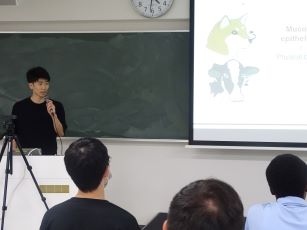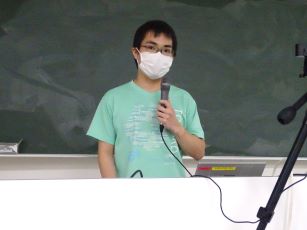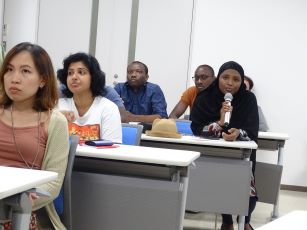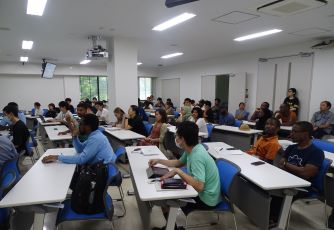- Home
- プログラム生/Ally生の活動報告
- 第6回 Student Monthly Progressを開催しました
第6回 Student Monthly Progressを開催しました
8月25日 (金)、第6回 Student Monthly Progressを開催しました。
3名の大学院生が自身の研究内容について発表を行いました。
【発表者】
1. HIRAISHI Masaya:Laboratory of Anatomy
<Mucosal immunity in the head of autoimmune disease-prone mice>
2. KOBAYASHI Daiki:Laboratory of Microbiology
<Loss of multiple N-glycosylations on the neuraminidase stalk domain enhances the pathogenicity of an H7N7 high pathogenicity avian influenza virus to chickens>
3. MEARS Chadwic De’sean:Division of Molecular Pathobiology
<Analysis of Mosquito-borne Sindbis virus and Eilat virus>
【座長】
HSU Ying-Yuan:Laboratory of Veterinary Surgery
BARNES David Atomanyi:Division of Bioresources
❖座長レポート❖
Below is a summary of the research progress presentation of the outstanding work of the three D2 students from diverse laboratories.
In his delivery, the first presenter HIRAISHI Masaya shed light on the intricate world of mucosal immunity by investigating its dynamics in autoimmune disease-prone mice (lpr). He explored the complex interplay between autoimmune diseases, mucosal epithelium, and mucosa-associated lymphoid tissue (MALT). The study's significant findings revealed the development of MALT in the heads of autoimmune disease models, suggesting that local cell proliferation plays a pivotal role in this process. In addition, the increase in goblet cells in nasal mucosa with nasal-associated lymphoid tissue development has potential implications for local mucosal immunity in lpr mice.
KOBAYASHI Daiki’s presentation delved into the realm of avian influenza viruses, focusing on the crucial role of neuraminidase (NA) proteins in viral pathogenicity. His analysis focused on the impact of glycosylation sites on the NA stalk in determining the pathogenicity of high pathogenicity avian influenza viruses in chickens. This insightful investigation not only illuminated the knotty interactions between viral proteins and host organisms but also holds potential implications for the effective prevention and control of avian influenza outbreaks.
The last presenter, MEARS Chadwic De’sean's presentation was on mosquito-borne viruses, specifically focusing on Sindbis virus (SINV) and Eilat virus (EILV). His comprehensive analysis investigated the growth kinetics and evolutionary relationships of SINV isolates, uncovering valuable insights into the genetic diversity and potential implications for viral distribution and pathogenicity. Furthermore, his research into EILV's replication capacity in insect cells contributes to our understanding of its potential as a vector-borne virus.
The event encompassed more than just presentations; it was an immersive experience. The student audience actively displayed their engagement by posing pertinent and intellectually stimulating inquiries to the presenters, igniting a dynamic exchange of ideas. These sessions not only propel the boundaries of our scientific understanding but also carry the potential to usher in practical solutions in the real world. This initiative serves a dual purpose: it acquaints students with research endeavors outside their immediate focus and nurtures a collaborative mindset.






